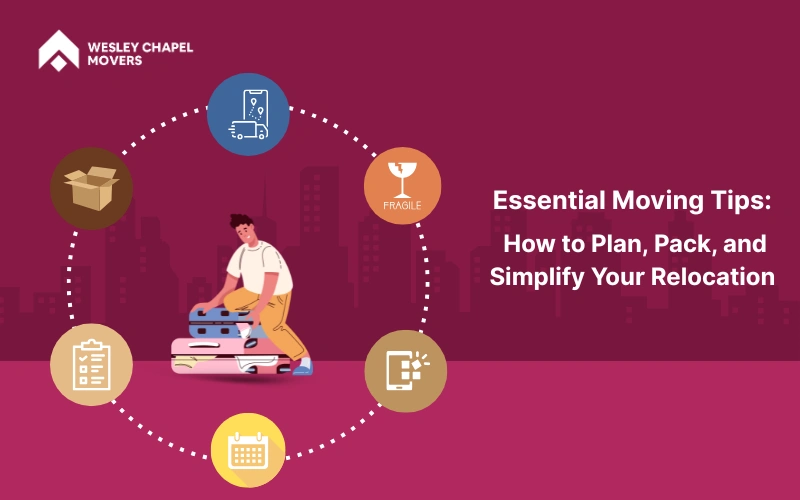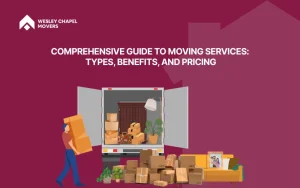Moving to a new home or office is an exciting yet challenging process, as without careful planning, relocation can lead to stress, unnecessary costs, and logistical headaches. The key to a smooth move is taking proactive steps to organize, pack, and manage tasks efficiently. Some key areas to focus on while moving are planning your move by choosing a moving date, setting up a timeline, notifying utility providers, and booking movers to prevent last-minute chaos.
Prepare a strategic packing plan and start by decluttering to lighten the load. You should use quality packing materials and clearly label each box to save time, money, and headaches later. Also, simplify the process using moving apps to manage inventories, track tasks, and provide checklists tailored to your situation.
Lastly, after moving, set up your utilities, update your address, and take time to unpack and settle into the new neighborhood smoothly. With the right approach to planning, packing, and simplifying the process, you can significantly reduce stress and feel confident in your transition. This guide will walk you through each stage of the moving process, offering actionable tips and strategies that will help you plan, pack, and simplify your relocation.
How Do I Plan My Move?
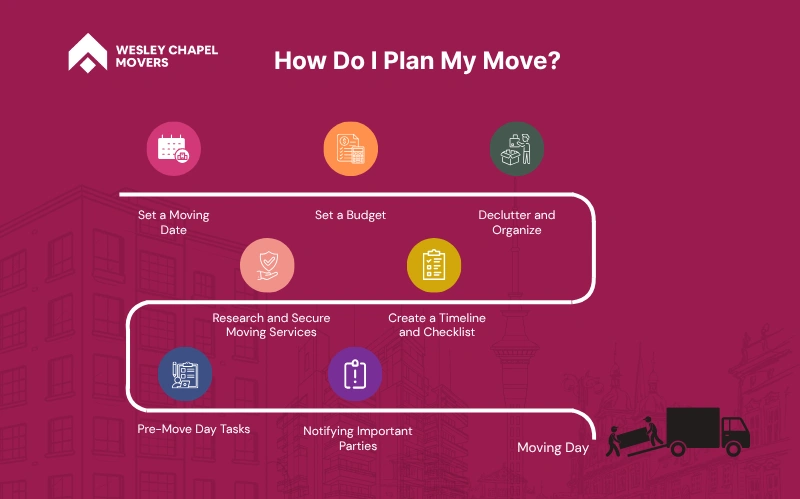
To plan your move effectively, start by organizing early, setting a clear timeline, and creating a realistic budget to avoid common issues like missed deadlines or last-minute chaos. Proper planning helps prevent costly mistakes such as misplaced documents or rushed packing, allowing for a smoother, stress-free relocation. Though it requires time upfront, a well-prepared plan ultimately saves time and reduces anxiety throughout the moving process.
Set a Moving Date
Selecting the right moving date is critical to avoid scheduling conflicts with movers, last-minute hassle, and rental overlaps. The sooner you choose a date, the more options and flexibility you will have. Here is how to choose the best moving day for your needs.
- Avoid Peak Seasons: Summer months and weekends are the busiest times for movers and typically come with higher prices.
- Consider the Weather: Weather conditions can affect your move. Choose a time of year that’s favorable for both you and the movers.
- Factor in Personal Commitments: Schedule around school calendars, work responsibilities, and lease agreements for smooth coordination.
To secure the best rates and availability, book your moving date as soon as possible to secure availability and get the best rates.
Set a Budget
Preparing a budget for your move is essential to avoid financial stress and keep spending under control. Also, knowing what to expect helps you plan smarter and make cost-effective decisions along the way.
Some of the key expenses during a move often include professional movers, transportation fees, packing materials like boxes and tape, and extras like moving insurance or tips. To save money, you can easily rent a truck instead of hiring movers, or use free packing supplies from local stores.
Whether it is last-minute supplies or extra help you did not anticipate, always include an extra amount in your budget for unexpected costs. Nonetheless, a well-planned budget helps keep your move on track and within your means.
Declutter and Organize
Decluttering before your move can save time, reduce moving costs, and make unpacking easier. Fewer items mean less packing, fewer boxes, and potentially lower moving fees. Here is how to efficiently organize your belongings:
- Sort by Category: Separate your belongings or items into “keep,” “donate,” and “discard” piles.
- Use the One-Year Rule: Sell or give away items you have not used in the last year.
- Start Early: Begin the decluttering process room by room several weeks before your moving day to stay organized.
Starting the decluttering process early to avoid last-minute clutter and stress ensures a smoother packing phase and makes the move more manageable.
Research and Secure Moving Services
Reviewing and finding reliable moving services early is a key part of the planning process. It is important to compare rates, services, get quotes, and check credentials to ensure you choose the right company and avoid scams.
You should get multiple quotes from different moving companies to compare prices, check for insurance options, and verify that the movers offer insurance and understand their coverage options. Lastly, read online reviews and look at customer feedback to ensure the company has a good reputation.
In addition, you can consider DIY options like renting a truck if you are on a tight budget. Book your moving services once you have confirmed the moving date to guarantee the company’s availability.
Create a Timeline and Checklist
A timeline and checklist are essential for staying on track and organized during the moving process. It helps break the whole moving process into manageable steps and reduces the risk of missing important tasks. Below is a sample moving timeline:
- 8 Weeks Before: Start sorting, decluttering, and packing non-essential items.
- 4 Weeks Before: Finalize your moving company and confirm the moving date.
- 1 Week Before: Finish packing, finalize moving day details, and prepare an essentials box.
Following your timeline and checklist helps ensure everything is completed on time, preventing any last-minute rushes and stress.
Pre-Move Day Tasks
The day before the move is critical for finalizing everything, avoiding last-minute chaos, and ensuring a smooth transition. Packing and completing all miscellaneous tasks ahead of time helps ensure a less stressful and smoother moving day.
Some key pre-move day tasks are:
- Finish packing and labeling all the items clearly.
- Pack an essentials bag with toiletries, clothes, snacks, and important documents.
- Double-check the moving schedule, including timing, payment details, and directions.
Review your checklist and ensure all preparations are complete to minimize stress on moving day. After getting everything in place, enjoy a smooth and manageable moving day.
Notifying Important Parties
Notifying key parties about your move is crucial to avoid service interruptions, updating your address, and ensuring everything runs smoothly before and after the move.
- Utility Companies: Transfer or disconnect services like electricity, water, internet, and gas.
- Post Office: Set up mail forwarding.
- Employer: Inform your boss if needed.
- Banks and Credit Providers: Update your address to avoid missed statements.
You should also notify your property manager or landlord, family, and close friends to ensure everything runs smoothly. Notifying these parties early ensures seamless service after the move and avoids service disruptions or missed mail once you’ve moved.
Moving Day
Being prepared and staying organized on moving day can make it more manageable by avoiding delays and costly mistakes. Here is what you need to do:
- Double-check that all boxes are packed and are properly labeled.
- Pack a “moving essentials” bag with necessary items like documents, chargers, and medications.
- Supervise the movers and the process to ensure everything is transferred correctly.
- Do a final check for any missed items and confirm payment and tips for movers if needed.
As moving day can be stressful, stay calm and organized for a smooth transition into your new home.
What Are the Best Packing Tips for Moving?
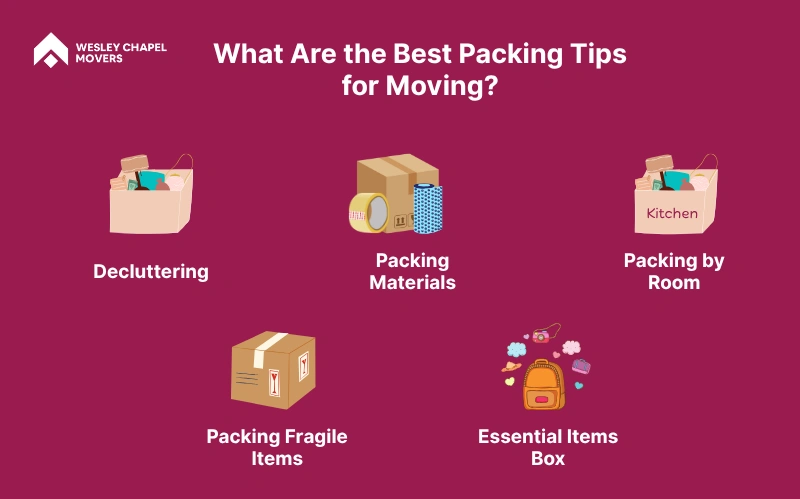
The best packing tips for moving include starting early, decluttering, using the right materials, packing room by room, and setting aside an essentials box for your first night. Efficient packing protects your belongings, reduces stress, and simplifies both the moving and unpacking processes. By organizing carefully and labeling everything clearly, you minimize the risk of damage and make settling into your new home much smoother.
Decluttering
Decluttering before packing helps significantly reduce stress and moving costs. You can lighten your luggage and make unpacking in your new space much easier by letting go of items you don’t use.
Start by sorting items by category, such as clothes, kitchenware, electronics, and only keep what you truly need. You can apply the “one-year rule” to items you have not used in the past year, and donate or sell non-essential items. For a smooth moving process, start early and declutter strategically to reduce moving costs and simplify packing.
Packing Materials
Choosing the right packing materials while packing ensures that your belongings are safe during transport and prevents damage in transit. Here are some essential packing materials:
- Boxes: Use small boxes for heavy items and large ones for light items.
- Bubble Wrap: Protect fragile items like glassware and electronics.
- Packing Paper: Wrap delicate items and fill empty spaces in boxes.
- Labels: Label each box with its contents and the room it belongs in.
Investing in quality materials is crucial to reduce the risk of damage during the move. It also ensures your items stay safe and intact, saving you stress and potential replacement costs.
Packing by Room
Packing room by room is a smart strategy to keep things organized and ensure that the move is smooth and simplifies unpacking at the new location. Here are a few room-by-room packing tips for easy relocation:
- Living Room: Pack electronics, books, decor, and furniture first, ensuring fragile items are well protected.
- Kitchen: Wrap fragile kitchenware and pack by category (plates, cups, etc.).
- Bedroom: Use wardrobe boxes for clothes and suitcases for smaller items.
- Bathroom: Pack toiletries in a small box and include essentials like soap, towels, and toilet paper for the first night.
You should start early and pack one room at a time to keep the process organized and manageable.
Packing Fragile Items
Fragile items like glassware, ceramics, and electronics require extra care to avoid breakage and costly damage during the move.
A few tips for packing fragile items:
- Use bubble wrap and padding to protect fragile objects like electronics, decor, and glassware.
- Pack glass items vertically to prevent chipping and fill any empty spaces in boxes with packing peanuts or crumpled paper to prevent shifting.
- Label boxes with fragile items to ensure careful handling.
Taking time for proper packing will minimize the risk of damaging and breaking your most valuable items.
Essential Items Box
An essentials box is crucial for moving day. It contains everything you need for the first night in your new home, saving you from digging through boxes when you’re tired and unpacking.
Here is a list of items to pack in an essential item box:
- Toiletries: Toothbrush, toothpaste, soap, toilet paper.
- Clothes: A change of clothes for the first day.
- Important Documents: Passports, IDs, leases.
- Chargers: For your phone and other electronics.
Pack your essentials box last and keep it handy to make your first night in the new home easier, comfortable, and stress-free.
How Can I Simplify the Moving Process?

To simplify the moving process, begin early with a clear plan, timeline, and checklist to stay organized and avoid last-minute chaos. Use moving apps to manage inventory, schedule tasks, and coordinate logistics, while delegating responsibilities like packing or cleaning to movers, friends, or family. Prepare for moving day by labeling boxes, setting aside essentials, arranging care for kids and pets, and organizing meals to ensure a smooth, efficient transition.
Use Technology And Apps
Technology is a powerful tool that has become a game-changer when it comes to simplifying your move. Today, there are a variety of apps designed to streamline everything, from organizing your packing to booking moving services, reducing the complexity and stress involved in relocation.
Moving organizer apps like Sortly or MoveAdvisor help you organize your packing, track boxes, and set reminders for tasks. Task management apps like Todoist or Trello are great for creating a task list, managing tasks, and delegating responsibilities, and Magicplan or Home Inventory track your belongings, and apps like U-Haul or Zipcar are useful for renting and managing moving trucks.
Delegate Tasks
Delegating tasks during your move is crucial to avoid burnout and ensure that everything gets done efficiently. Moving is a large project, and handling it all alone can lead to unnecessary stress and delays. Here’s how to delegate tasks effectively.
You should ask family and friends for helpwith packing, lifting boxes, and organizing, or hire professional movers for heavy lifting and transportation. Also, you can hire a cleaning service to handle all the cleaning work, and use moving services to save time on packing and reduce stress. Delegating tasks effectively ensures a smoother and more manageable move.
Prepare for Moving Day
Preparing ahead of time for moving day is critical for a smooth move. The more you handle in advance, the less stressful and chaotic your moving day will be. Always make sure all boxes are packed, sealed, and clearly labeled before moving day, and confirm your moving details, including mover arrival times and directions to your new home.
Also, pack a moving essentials bag with toiletries, a change of clothes, important documents, and chargers. By completing these final tasks the day before your move, you can ensure everything goes as planned and make moving day less stressful.
Make a Plan for Pets and Kids
Moving with pets and children can add complexity to your move. Proper planning and management are essential to minimize the stress for both you and your family members during the transition.
For pets,arrange a pet sitter to take care of them or drop them off with a friend during the moving process to keep them safe. In addition, for kids, keep them entertained with snacks, games, or books, or have them stay with family or friends on moving day to reduce distractions.
Food and Refreshments
Preparing meals and snacks for moving day is crucial to keep everyone energized and hydrated, especially during a long or physically demanding move. Packing food and drinks in advance will help everyone stay focused during this physically demanding process.
Prepare simple meals like sandwiches, pizza, or ready-to-eat salads, and stock up on snacks such as granola bars, fruit, chips, and bottled water. If you’ve hired movers, offer them drinks or snacks, and organize meals and snacks in advance to ensure everyone stays fueled and focused throughout the day. This reduces stress and keeps things on schedule.
How Do I Handle Transportation and Logistics?
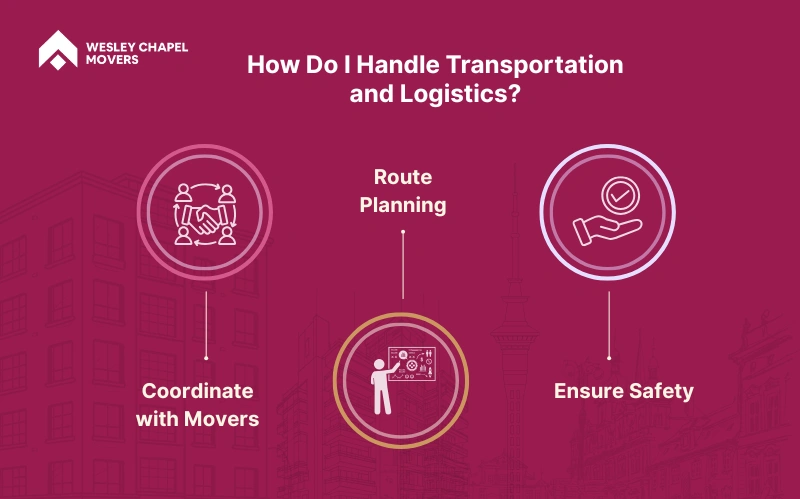
To handle transportation and logistics effectively, you need to plan proactively by booking movers or trucks early, mapping out travel routes, and ensuring safety measures are in place to avoid delays, damage, or confusion. Every detail, from confirming moving schedules to securing items in transit, plays a critical role in keeping your move efficient and stress-free. Poor coordination can result in unexpected costs, broken items, or timing issues, so it’s important to finalize all logistics well in advance and stay organized throughout the process.
Coordinate with Movers
Effective coordination with movers starts by confirming the moving date, time, and the exact services you require, such as packing, lifting, or transport. Whether you are working with professional movers or friends and family, communicate clearly about the layout of your home, any fragile or bulky items, and potential access issues like stairs, narrow hallways, or parking restrictions. Make sure everyone understands their roles and responsibilities, and maintain contact on moving day to handle any last-minute changes or updates.
Route Planning
Smart route planning begins with identifying the best route to your new home, using navigation apps like Google Maps or Waze to track traffic, closures, or construction delays. Plan for alternate routes in case of emergencies and aim to travel during off-peak hours to avoid congestion. Factor in weather conditions by checking forecasts in advance, and allow buffer time to deal with unexpected delays. A well-planned route can significantly cut down on travel time and reduce stress during the move.
Ensure Safety
Prioritizing safety involves preparing your home and transport vehicle to prevent accidents and injuries throughout the moving process. Keep pathways clear of obstacles like loose cords or boxes, and use proper lifting techniques by bending at the knees instead of the back to avoid strain. Secure items in the moving truck using straps, padding, and blankets to prevent shifting during transport. Equip yourself with protective gear such as gloves, closed-toe shoes, and back support if needed. These precautions help ensure that both people and possessions remain safe during the move.
What are the key post-move tasks, and How Do I settle them?
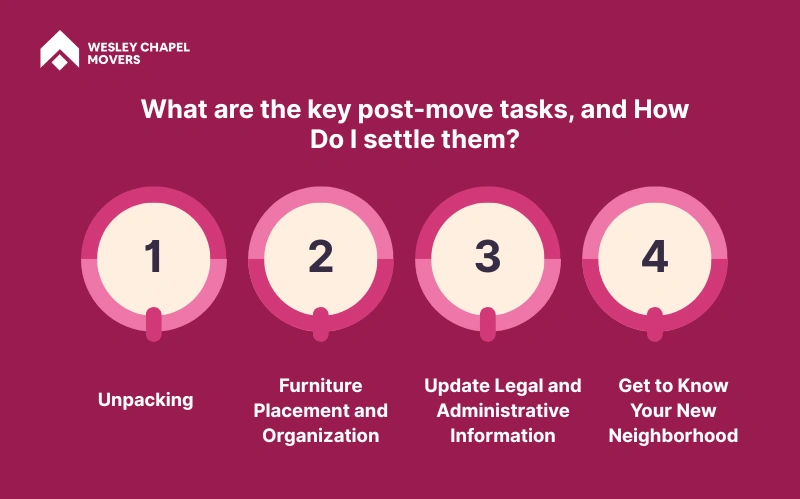
The key post-move tasks include unpacking, arranging furniture, updating your address, and exploring your new neighborhood to settle in smoothly and comfortably. Handling these responsibilities methodically helps reduce stress, improves daily functionality, and accelerates your adjustment to the new environment. Staying organized and proactive during this phase ensures a more seamless and pleasant transition into your new home.
Unpacking
Unpacking in a systematic, room-by-room manner allows you to quickly restore order and functionality in your new home. Begin with essential items like toiletries, kitchenware, and everyday clothing. Organize unpacked belongings by category, such as books or electronics, and dispose of packing materials promptly to maintain a tidy space. Stretching the unpacking process over several days can help prevent exhaustion and make the experience more manageable.
Furniture Placement and Organization
Timely updates to your address and legal records ensure continued access to important services and mail. Set up mail forwarding with the post office and notify agencies like the DMV and IRS of your move. Also, update your address with banks, utility providers, healthcare institutions, and subscription services. Completing these steps promptly protects your access to critical services and ensures all records remain accurate.
Update Legal and Administrative Information
Familiarizing yourself with your new neighborhood builds comfort and helps you integrate into the community. Begin by visiting local amenities such as grocery stores, pharmacies, restaurants, and parks. Discovering transportation options, community centers, gyms, and libraries enhances your sense of connection and belonging. Active exploration encourages a smoother emotional and logistical transition.
Get to Know Your New Neighborhood
It is important to get familiar with your new neighborhood to feel comfortable at home. Likewise, exploring new areas helps you discover services, making the transition smoother and more enjoyable.
You can start exploring by visiting nearby stores, parks, restaurants, local gyms, libraries, or community resources. Also, check out local transportation options like bus routes to help you feel more connected and settled in your new surroundings.
How Do I Manage Timing and Deadlines?
Effective time management is key for a successful and stress-free move. By organizing tasks and setting deadlines, you can break the moving process into manageable steps, helping you stay organized and avoid last-minute chaos, making sure everything is completed on time.
Most moving tasks, such as packing, cleaning, or organizing, take longer than expected, so it’s important to plan wisely. Schedule professional services like movers, cleaners, or packers well in advance to secure availability and avoid higher last-minute rates.
Creating a realistic moving timeline tailored to your needs helps you stay on track, reduces stress, and ensures nothing important is overlooked during the transition.
How Do I Ensure Safety During the Move?
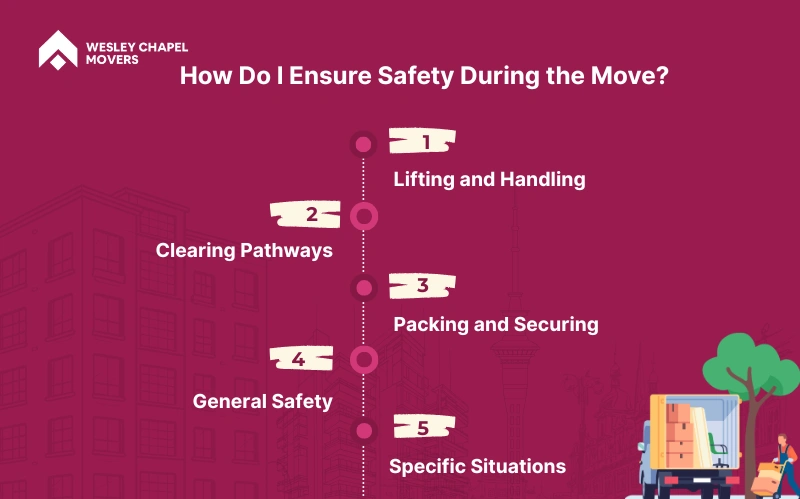
Safety is a top priority during a move to prevent injuries, damage to belongings, and accidents. Taking proper safety precautions ensures that everyone involved remains safe and the move goes smoothly.
Throughout the move, use proper lifting techniques like lift with your legs, not your back, and consider using moving straps or dollies for heavy items. Keep walkways clear to avoid trips or falls, and wear sturdy shoes and gloves for protection. By prioritizing safety during packing, loading, and transport, you can ensure a smoother, injury-free move for everyone involved.
By prioritizing safety during your move, you’ll prevent injuries, protect yourself and anyone helping, and also keep your belongings intact.
Lifting and Handling
Using proper lifting techniques is essential to avoid injury and make the moving process smoother. If handled incorrectly, heavy items can strain muscles or cause accidents. Always bend at your knees and lift with your legs, not your back, to prevent back strain.
Utilize moving straps, dollies, and hand trucks to assist with lifting heavy items and for large, bulky items, enlist a helper to share the load and ensure better control. Using proper lifting techniques reduces the risk of injury and makes the moving process more efficient.
Clearing Pathways
Keeping the moving area free from obstacles is essential for ensuring that everyone involved in the move can move freely and safely. Clearing pathways will reduce the risk of accidents and help the move go smoothly.
Before the move, clear furniture, rugs, or any obstacles that might cause tripping. Make sure there’s enough room around doors, hallways, and stairs for large items to pass through. Ensure that the moving area is well-lit, especially in dark areas or at night.
Packing and Securing
Proper packing and securing of your belongings is crucial to prevent damage during the move. When items are packed securely, they’re less likely to shift, break, or cause injury during transport.
You can use bubble wrap, packing paper, or towels to protect fragile items like glassware and electronics. Protect boxes with extra tape to avoid them breaking during the move, use packing peanuts or crumpled paper to fill gaps in boxes and prevent items from shifting, and mark boxes with fragile items and instruct movers to handle them with care.
General Safety
In addition to specific tasks like lifting and packing, there are general safety precautions that can help avoid injuries and accidents using the right equipment and taking care of yourself during the move. These safety precautions help prevent accidents and make the process more efficient.
Wear non-slip, sturdy shoes to protect your feet and gloves to protect your hands. Long-sleeved clothes protect against scrapes. Also, ensure all tools and equipment are safely stored when not in use to prevent accidents, and avoid using makeshift tools. You should always use dollies, straps, and blankets when moving heavy or fragile items.
Specific Situations
Some moving situations, such as handling large furniture, navigating stairs, or moving through narrow spaces, require extra caution. These situations pose a risk for injury or damage when not managed properly, so being prepared helps prevent accidents.
For bigger furniture pieces, use moving straps or additional help to maneuver bulky items, or consider hiring professional movers with specialized equipment for particularly heavy pieces. When moving furniture up or down stairs, get a helper at the top and bottom for better control. Also, use furniture sliders or hand trucks to move items through tight spaces without damaging walls or furniture. Preparing for specific challenges ensures that these difficult parts of the move go smoothly and safely.
How Professional Moving Help Can Make Your Relocation Easier
Moving can be a hectic event, but hiring professional help can make the process smoother, less overwhelming, and faster. Trained movers handle logistics, packing, and heavy lifting, which helps avoid damaged belongings, last-minute chaos, and physical strain. Professional moves bring the expertise and efficiency needed to get the job done. DIY moving seems efficient, but comes with challenges like coordinating transportation, navigating tight spaces, and lifting bulky items, which can lead to costly damage. This is where professionals like Wesley Chapel Movers come in handy. By hiring us, you can enjoy stress-free, reliable, affordable, and professional moving services tailored to residents in the Wesley Chapel area. Book your moving service with us today and let our expert team handle everything.
